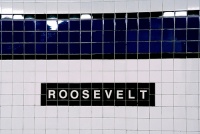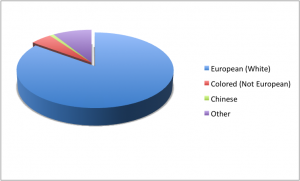Views
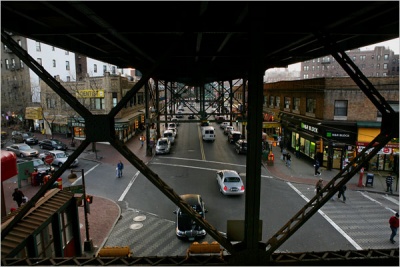
When you're bored of all of this, check these out:
Woodside: The Not-So-Serious Stuff
A More Basic Overview
Interview with Andrew Vertullo
Creative Accent: A Study Across Generations
Conclusion: My Views on Housing in Woodside
Extra: Go here [1]
Contents |
Woodside:The Serious Stuff(In Great Detail)
Woodside is a neighborhood in the borough of Queens located in the state of New York. Its zip-code is 11377, and its boundaries are Jackson Heights and Elmhurst to the east, Sunnyside to the west, Maspeth to the south, and Astoria to the North.[2]
View Woodside in a larger map
Early History
The area that is now known as Woodside began as one of the earliest European settlements in West Queens. It had been occupied by the Lenape Native Americans, who were displaced by the Dutch colonialists after Governor Kieft’s War in 1640 and the Peach War in 1655. It did not experience substantial development until the 1800s, and was described as an “isolated area of snake-infested swamps and wolf-inhabited woods”.[3]
In the time before it was developed, the area of Woodside was plagued by high infant mortality, high rates of suicide, and overall short life expectancy. This was because of illness, attacks from Native Americans, and other characteristic troubles of living in the wild. Early Woodside was known as ‘suicide’s paradise’ because of the many colonialists that would go to Winfield Woods (once a part of the area of Woodside) to commit suicide, and because of the of cemeteries in the area, namely Mount Zion and New Calvary. In the 19th century, he area was part of the Town of Newtown. The adjacent area, called Winfield, was largely incorporated into the post office serving Woodside. This resulted in Winfield's loss of identity to the neighboring Woodside.[4]
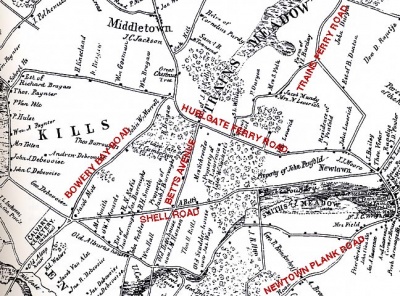
Founding Families

The Sackett family was a Puritanical family who came from England originally to Cambridge, Massachusetts in 1628. Simon Sackett left two sons, one also named Simon, and the other John. Simon Sackett’s son, Joseph, left four sons and three daughters. Two of his sons inherited his land in the area that is now Woodside. Eventually, others in the lineage continued to inherit land around Woodside. John Sackett gained two lots separated by Hurl Gate Ferry Road, which is today’s Woodside Avenue. This lot extended to what would today be known as Broadway, and bordered Woodside Avenue on the west. John’s son would eventually live with his wife on the Sackett Farm and build the farm into a manor, leaving the property to his son. Two generations later, this property, and mansion would be sold to John A. Kelly.[7]
His son, John A.F. Kelly would go on to coin the name of the neighborhood and launch the land into its first major developments. John A.F. Kelly was part owner of the Independent Press of Williamsburg, and wrote “Letters from Woodside” which were articles based on the nature-ridden view he had from his window. This name stuck when developer Benjamin Hitchcock purchased the remainder of the “Woodside Estate” in 1867. Prior to this in 1860, the LIRR bought some of the estate for a stationhouse to be constructed on. This LIRR stop was the first development that would change Woodside into an actual destination rather than a point one passes during travel.
The Role of Transportation in Development
Transportation would make it easier for people to arrive to and depart from Woodside, increasing the ease with which Woodside dwellers could travel and thus improving the practicality and appeal of the area. In 1869 a new rail station at 58th Street and 38th Avenue was built and the old one closed. This continued to accelerate the development of the community. As transportation increased, accessibility became a reality. Citizens could commute to work in other places expanding the labor market and financial opportunities for those in Woodside. The Long Island Railroad also would soon merge with the Flushing Railroad, and the Woodside Station was eventually opened. In the 1890s the population in the area of Woodside doubled because of both Hitchcock’s development success, the attraction of other developers to the area, and the expanded transportation. Then in 1909 when the Queensboro Bridge was opened, the population quadrupled. The prior arrivals of the trolley in 1895 and the arrival of the elevated tracks in 1917 would also attract people to the area, further increasing the population. The evolution of transportation in the area catalyzed the major planning that would take place in terms of housing development.
Housing
1867, Benjamin Hitchcock had initially launched a housing development plan. It involved 972 numbered lots that ranged from cottage to mansion.[8] The influx of immigrants, however, made it necessary to reconsider accomodating the spatial and financial needs of the newcomers. In 1924 the City Housing Corporation, a new organization, began building private homes in Woodside. That being said, the Cosmopolitan apartments that were built by Metropolitan Life Insurance made Woodside a more urban area. Here there was a fundamental disagreement with the plans for the community. Should the neighborhood be preserved as a quaint suburb or be transformed into an urban mosaic? Some were not convinced of the glory that came with assimilation and the resources that immigrants had. Tenement housing became an issue because of the low incomes of the families. This brought overcrowding and aggravated issues of disease and poor hygeine that came along with tenements and flats. Solutions were proposed to provide affordable housing to immigrants and stop the popularity of overcrowding in homes. One such project was launched in the 1960s when the Big Six Towers were opened which replaced tenements and flats with modern affordable housing. These efforts were put into place to stop the conversion of one family homes into illegal dwelling places where immigrants packed like sardines and lived in poor conditions.
What About Now
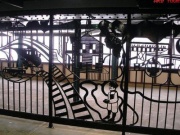
Today, the neighborhood of Woodside is home to a large population of Asians, Hispanics, a few clusters of Eastern Europeans, and the enduring presence of Irish immigrants and culture. Currently, Woodside has a population of nearly 90,000 people including a strong Bangladeshi and Filipino presence, which are coexisting with the strong Irish and Italian communities. The dynamics of living is fascinating in Woodside because of its diverse makeup and extensive history. Who lives where, and how? Is it the presence of Mexican businesses that brings Mexican families to live in the area, or is it the Mexican presence as citizens that bring the demand for business? Did the need for transportation to places with more work bring immigrants to settle in Woodside, or instead was it the influx of immigrants to Woodside that made it necessary for extensive transportation in and out of the neighborhood? From 1900 to the present, Woodside has changed drastically. The growing population and influx of immigrants made the issue of housing (including real estate to racial cohabitation) a major institution to be considered.
Immigrants and Housing
What draws immigrants to living in Woodside? The 108th precinct would claim that it’s Woodside’s low crime rates that are responsible for the diversity of the population. Others insist that it is the proximity to three subway lines (V,R,7--and G, sort of)as well as the LIRR, Northern Boulevard, and other major roads. Development is the biggest issue in Woodside because of the large number of immigrants who live and continue to come here. Essentially, the 20th century brought along with the growing population, the issue of where in Woodside people would live, and how they would afford it. Low-income tenement housing which was hardly legal and rarely sanitary became a noteworthy problem. Solutions were proposed to provide affordable housing to immigrants and stop the popularity of overcrowding in homes. One such project was launched in the 1960s when the Big Six Towers were opened which replaced tenements and flats with modern affordable housing. These efforts were put into place to stop the conversion of one family home into illegal dwelling places where immigrants packed like sardines and lived in poor conditions. Also, the transportation projects of the time were displacing residents. Many Woodside houses were either torn down for construction of the BQE, LIRR, IND and IRT subway lines and the creation of new streets. The removal of more space from a to-be even more significantly crowded area did not help the housing development situation.
The Effects of Development
Today, large new apartment buildings are built and the conversion of single-family homes into multiple occupant buildings is popular. This provides a way for landlords, who are often enough also immigrants (from either the first or second generation), to collect rent from either those of the same culture who they themselves linked into the ethnic chain-like community of Woodside, or even to “help out” undocumented immigrants who could not otherwise rent an apartment. The biggest issue that arises here is that of crowding.
Crowding
Because of the crowding in the area, and the sharing of what should be one-family homes by multiple, there is also overcrowding in the schools. This would make living in Woodside less desirable to those with higher incomes who could afford the apartments and houses being sold as they are. As a result, the tradition of illegal dwellings has been continued.
Demographics
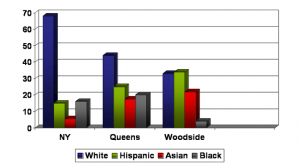
The chart above shows demographic information from the 2000 Census. Demographics in the area are vital when studying housing. The more industrial areas are home to more recent immigrants, thus their populations are composed primarily of Hispanics, Filipinos, and other “not white” groups. Woodside holds one of the largest concentrations of Filipinos. The less recently migrated generations move outwards in Woodside to wealthier areas. The major shift from a primarily Irish area to a neighborhood that houses people of many ages, races, educational levels, and occupations most recently was seen in the 27,500 newcomers that arrived during the years 1990 through 2000. During this time, the population grew by 30% and only 10% have actually been naturalized. With about one quarter of the population being between the ages of one and nineteen, these statistics become even more interesting. Only about 61% of Woodside’s current population being legal United States citizens, there are a lot of enduring questions. Where did the most recent wave that brought so many undocumented immigrants come from? Latin America and Asia have contributed a combined 89% of the population of immigrants that came between 1990 and 2000. Even since 2000, the Caucasian population has continued to decrease at the same rate as the Hispanic population is increasing. The result? Ethnic succession. The Hispanics and Asians, along with other incoming foreign-borns are occupying the lower rungs and niches that the Irish (and other Europeans) had previously settled into.
Changes from then to now
Woodside has historically been the largest Irish American community in Queens. In the early 1930s, the area was 80% Irish.[11] Even as the neighborhood has seen growth in ethnic diversity today, the area still retains a strong Irish American presence. There are Irish pubs/restaurants scattered in Woodside.
In the early 1990s, many Asian American families moved into the area, particularly east of the Woodside–61st Street. Woodside's population is now 30% Asian. Woodside has a large population of Koreans, Chinese, and Filipinos and enclaves of each ethnicity. There are also Indian, Bengladeshi, and Pakistani inhabitants as well as a large Latino population made up mostly of Colombians, Ecuadorians, Mexicans, and Dominicans.
The neighborhood is filled with Irish pubs and Thai, Filipino, Colombian, and Ecuadorian eateries at which members of those respective ethnicities are employed. There is an area known as Little Manila from 63rd-71st Streets at the strip of Roosevelt Avenue, where many Filipino businesses have been flourishing.
Where do they live and what do they do?
Historically, in the 19th century, Woodside was home to working class Europeans, primarily Irish. Many worked in blue-collar occupations.
In terms of residency, these people stay where they can afford, and they can afford what their jobs can finance. 28% of the population in 2000 over the age of 25 did not complete high school, while 23% have a bachelor’s degree or higher. Many immigrants that graduated in their countries of birth, however, do not work in their old fields. Therefore, the majority in Woodside is working class or does clerical work while a few own small businesses. These businesses are usually passed down in the family, such as Northern Deli on the corner of Northern Boulevard and 69th street. The result of the working-class influx to Woodside has been “an …almost affordable residential place for low income people (urban correction has been made to fit the goal).” What this means is that the more immigrants that move into Woodside after emigrating from their countries of origin, the more accommodations that will be made to suit the housing needs of these demographics. Private homes that would sell for around $600,000 today are being torn down and replaced with affordable apartment buildings to suit the average income of about $50,000 a year made by residents.
Sections of Woodside
To the southeast of Woodside, north of Queens Boulevard, development of this sort continues. A six-story residential building is constructed in the place of an old house, alongside a 227 year old tree which the neighborhood compromised to preserve.
North of this business district is the area around Broadway and Northern Boulevard which has two-story brick houses with driveways, an area that is still primarily European which holds a majority of the Irish presence. There are some scattered industrial areas along Broadway as well, interrupting this suburban atmosphere, though residential construction is being considered here as well. A lumber store becomes a condominium while Community Board Members try to preserve blue-collar jobs for Woodside’s residents. [12]
To the northwest near Astoria is Boulevard Gardens which is a complex of 10 buildings, each with six stories. These units attract those who want to live in a comfortable suburban atmosphere with medium or “relatively low” maintenance fees. [13]
The mortgage crisis has limited some residents from moving into Woodside, because certain co-ops like the aforementioned Boulevard Gardens do not allow more than thirty percent of a resident’s income to go toward rent and mortgage. The decrease in loan availability has limited potential buyers. With the economy in the state that it is in, they find themselves with less and less options. Single-family homes are now selling for about half a million dollars, or slightly more. Two-family houses which are popular in the area can sell for above $700,000. Three family houses are even selling for less than $900,000 today. For the co-ops at this point in time, $200,000 is average for a one bedroom, and slightly more for two. The better condition of the condo, the higher the prices are. For renting apartments, a one-bedroom costs around $1200 a month while two-bedrooms hover around $2,000.
[14]
A Woodsider's Perspective
From the perspective of a Woodside resident, the divide between the lower-middle class and upper-middle class is growing stronger. Near subway stations, more Hispanic immigrants as well as Indonesians and other non-Caucasian groups are forming small enclaves. Negative externalities such as cemeteries or subway noises lower the values of homes in the area. For this reason, cheaper apartment buildings are found in these areas to cater to the influx of lower-income residents that arrive or continue to live in the area. This contrasts greatly, however, with other parts of the neighborhood of Woodside. [15]
Areas off of Northern Boulevard continue to house a strong European presence, and the average incomes of the families seem to be growing. Improvements on these characteristic brick houses are occurring more and more. A renovation here, an added canopy there. It is relatively obvious that what once used to be lower-middle class Irish and Italian workers have evolved into businessmen and women earning higher salaries. It is for this reason that they choose to live in this portion of Woodside, near the LIE, BQE, and Northern Boulevard highways, Triboro Bridge, and other roadways that allow them to easily commute in and out of Queens. With higher concentrations of occupants with greater incomes as generations progress, come more improvements, stronger economic success, and growing neighborhood success.[16]
Ms. Fiona Gallagher, who "followed word of mouth" to Woodside says that it has been helpful for her as an immigrant to know the right people. She finds out where to go, and who to speak to through her ethnic ties in this very Irish neighborhood.[17]
Andrew Vertullo, a 26 year old who grew up in Woodside and attended St. Sebastian's School was interviewed by Newsday about the neighborhood of Woodside. He finds the area to be trendy because of the multitude of Irish bars, as well as basketball courts and the recreational center at St. Sebastian's school. The major issue in the area is the graffiti, as he says it has deterred newcomers. He also says the area has remained greatly the same, and that it is versatile. Everyone can find something to like about woodside. For the full interview click here: Interview with Andrew Vertullo [18]
Notes
- ↑ http://www.nytimes.com/2008/03/16/realestate/16livi.html?sq=woodside%20queens&st=cse&scp=1&pagewanted=all
- ↑ "Woodside, NY." HomeFinder. 2009. Classified Ventures. 17 Apr 2009 <http://www.homefinder.com/NY/Woodside/school_35940-Is_125_Woodside>
- ↑ "Woodside." Woodside, NY-Neighborhood Research. MaxHomes. 17 Apr 2009 <http://www.maxhome.netfirms.com/index.htm>.
- ↑ Queens Community Boards, New York City. Accessed September 3, 2007.
- ↑ http://www.forgotten-ny.com/NEIGHBORHOODS/woodside/woodside.html
- ↑ http://longislandgenealogy.com/KellyFamily/WoodsideQueens.html
- ↑ http://longislandgenealogy.com/KellyFamily/WoodsideQueens.html
- ↑ Photographic History of Woodside
- ↑ http://queens.about.com/od/photogalleries/ss/woodside-queens_8.htm
- ↑ http://www.maxhome.netfirms.com/historical%20background.htm
- ↑ Bayor and Meaghar (1996). The New York Irish. Johns Hopkins University Press. ISBN 0-8018-5199-8.(p. 414)]
- ↑ http://www.nytimes.com/2008/03/16/realestate/16livi.html?sq=woodside queens&st=cse&scp=1&pagewanted=all
- ↑ http://www.nytimes.com/2008/03/16/realestate/16livi.html?sq=woodside queens&st=cse&scp=1&pagewanted=all
- ↑ http://www.nytimes.com/2008/03/16/realestate/16livi.html?sq=woodside queens&st=cse&scp=1&pagewanted=all
- ↑ http://www.nytimes.com/2008/03/16/realestate/16livi.html?sq=woodside%20queens&st=cse&scp=1&pagewanted=all
- ↑ http://www.nytimes.com/2008/03/16/realestate/16livi.html?sq=woodside queens&st=cse&scp=1&pagewanted=all
- ↑ http://www.nytimes.com/2008/03/16/realestate/16livi.html?pagewanted=print
- ↑ http://www.newsday.com/news/local/newyork/am-city0720,0,1354404.story?page=3

